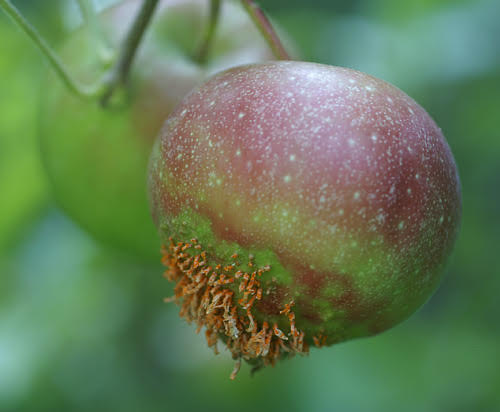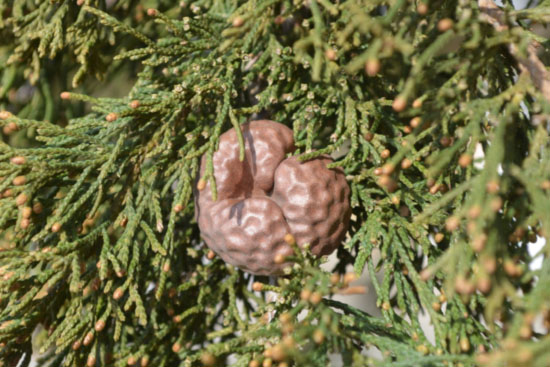Cedar Apple Rust (CAR) is a fungal disease that attacks apples. It mainly occurs in North America in areas east of the Rocky Mountains. This fungus requires two hosts to complete its life cycle: the apple (Malus) and the Eastern Red Cedar (Juniperus). Only spores produced on cedar can infect the apple. Similar cedar rusts can also affect pears, hawthorns, quinces, and serviceberries/juneberries.

Once CAR has overwintered in galls on cedar trees, spring rains can cause horn-like structures to protrude from the galls. These structures, called telia, can then become jelly-like and swollen. When the telial horns absorb water, tiny spores inside the structure germinate and are discharged in the air, which is how CAR reproduces. Any spores that land on young apple tissue may germinate and infect the tree if enough water is present and the temperature is between 46 to 75 degrees Fahrenheit. Humid spring conditions are ideal for infection.
Once an apple tree is infected with the rust, small yellow spots will appear on the leaves and fruit. These will later expand and turn orange, with brown hairy gall structures appearing on the underside. Infected fruit will be small, malformed, and may drop before reaching maturity.
Management of Cedar Apple Rust

Cedar Apple Rust spores can travel up to 4 miles, so your trees may be at risk of infection even if there isn’t an Eastern Red Cedar or Juniper on your property. Removing nearby trees of this type is still a good way to reduce the chance of infection. There are also several apple cultivars that are resistant to CAR and can be planted when available in order to reduce instances of this fungus. Another easy way to reduce infection is to rake up and dispose of fallen leaves and fruits from under the tree in the fall and remove galls from nearby cedars. If CAR is a big problem for your orchard, preemptive organic fungicide sprays of copper or sulfur in mid-spring after the spores have been released from the cedar host may reduce infection. Neem oil may also help to a lesser degree. This spray should be done around the time of tight cluster in apples (when leaves and buds are present, but before the blossoms open up). Spores are only released once in spring, so spraying during the growing season is not effective.


MORE INFO:
http://www.johnnyseeds.com/assets/information/actinovate_fact-sheet.pdf
http://nysipm.cornell.edu/factsheets/treefruit/diseases/car/car.asp
This edition of POP Tips prepared with assistance from POP Intern Nettie Baugher.
SUPPORT US! If you found this entry useful, informative, or inspiring, please consider a donation of any size to help POP in planting and supporting community orchards in Philadelphia: phillyorchards.org/donate.